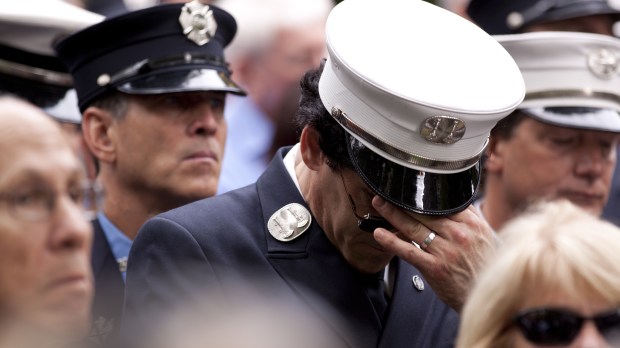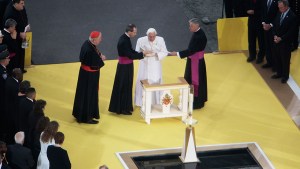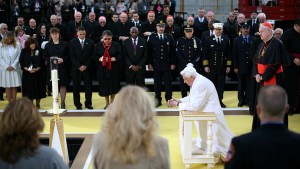Following the February 26, 1993, terrorist attempt to bring down the Twin Towers of New York’s World Trade Center with a truck bomb, visitors to the complex were carefully screened at the entrance. The procedure, which was a new phenomenon for most New Yorkers then, reflected an assumption that any future attempts to attack the building would come through the front door, the service entrance, or the parking garage.
So when Kathleen Curatolo heard that a plane had hit one of the 110-story towers on a bright, clear Tuesday morning in September 2001, she thought it might have been a small private aircraft flying off course.
That was many people’s initial reaction. Hardly anyone, except perhaps people working in military or government intelligence, imagined that terrorists would fly a large commercial airliner into a skyscraper.
But the situation quickly became all too clear to New Yorkers, including Curatolo, a Catholic school principal who was on her way that morning to a regional meeting of her peers.
“When I got to the principals’ meeting I told everyone else what I’d heard on the radio, so we turned on the TV. And we watched the second plane crash,” Curatolo said.
The meeting was promptly canceled, and all the principals returned to their respective schools. Curatolo’s school, Immaculate Conception in the New York City borough of Staten Island, had students gather in the gym, “so kids could be together with siblings and teachers could have the support of each other, because it was a scary day,” Curatolo recounted. She led the eighth-graders to the roof of the school for an impromptu prayer service. There, they had a pretty good view of lower Manhattan and could see the large plume of smoke coming from the burning buildings. But as soon as they finished praying, the kids went back downstairs — fortunately, just before the second tower collapsed. Curatolo and the custodian, however, stayed on the roof and saw the collapse happen.
“We were just horrified,” she recalled. “You can’t believe such massive structures can come down, and then you think of all the people. You hope … like at that point we didn’t know really what was going on. You hoped they got out, but you knew they couldn’t all get out.”
Unknown to her at the time, however, was the fact that the collapse she witnessed took the life of her very own brother. Robert Curatolo, 31, was the youngest of eight Curatolo siblings. Like two of his brothers, he was a New York City fireman. Another brother was a New York policeman. Robert had just gotten married three weeks earlier.
“A six-year FDNY veteran, he had just gone off duty when the World Trade Center call came in, and he responded anyway,” according to the National Fallen Firefighters Foundation. He and two colleagues survived the first tower collapse. “A fellow firefighter captured the courage of Curatolo and Lieutenant Ray Murphy on film after the first tower collapsed as they walked, covered with dust, toward the other tower.”
At that point, Curatolo pulled somebody with two broken legs out of rubble.
“My brother was a basketball coach, and he had a deep loud voice that he used on the court, and apparently that day he was yelling at people to run, because the debris was falling from the building and you couldn’t stand around because you’d be hit,” she said.
His body was found two days later.
“When the building was collapsing, he dove under the fire truck, which is what they teach you to do: you get under the truck behind the back axle,” Kathleen Curatolo said. “Except that the building fell on the truck, and the truck crushed him.
“We know what happened. We’re lucky in that way. So many people have no idea,” she said.
Curatolo was one of 343 firefighters who died that day. In addition, 23 New York police officers and 37 New York and New Jersey Port Authority police officers lost their lives on 9/11.
In 2008, Kathleen Curatolo was one of 24 people to meet Pope Benedict XVI at his visit to Ground Zero.
“I had my brother’s funeral card with his picture on it and his badge I had pinned to my dress,” she said. “When I got up to the pope he asked me ‘Is that your brother?’ I answered yes, and he said ‘I’ll pray for him.’
“And of course,” she said, “then I started to cry.”
Uttering a prayer, and then running
On the morning of September 11, Deacon Narciso Hernandez, who has served for decades at Our Lady Queen of Martyrs Church in upper Manhattan, was working at Deutsche Bank across the street from the World Trade Center. He was on the 39th floor when he and his coworkers heard the immense impact from the first 767 hitting the North Tower.
“My boss came running and said ‘Be careful. Nobody move. Stay in place.’ So I stayed there,” Deacon Hernandez said. “As I was looking out the window, seeing things falling down from Tower One, all of a sudden I see a plane coming pretty low, vooom, and hitting Tower Two, right in the middle.”
He realized it was about 9 o’clock and had a sudden pang. “I said ‘My God, my daughter is supposed to be there, on the 103rd floor.’”
Wanda Hernandez, then 31, worked for Aon Corporation in the South Tower of the World Trade Center.
Deacon Hernandez and his coworkers evacuated the Deutsche Bank building, and when he got down to the street, he looked up at the two massive towers, by then both on fire. He could see people who apparently were jumping from the upper floors, desperate to escape the encroaching flames and intense heat. “I was only thinking about my daughter Wanda,” he said. “Something told me, ‘Well, you can’t run into the building, but you can try to reach home.’ Any news would come home.”
He uttered a prayer of thanksgiving for his daughter’s life. Then, as the subway system was shut down, he used a combination of ground transports to get back to his apartment in upper Manhattan by noon.
Happily, his daughter was there already. Unknown to Deacon Hernandez, she had been running late to work that morning because she needed to take her two children somewhere. By the time she was on the subway to work, she got news about the attacks and decided to turn back.
“My daughter was thinking I had perished, and I was thinking about her,” said Hernandez, then 52. “So my wife, my daughter and I cried together for half an hour. Everybody was crying. Two of my brothers were here, too. Oh my God, what a day.”
Wanda’s company suffered the loss of 175 employees. Hernandez himself knew many people who had died in the Trade Center, where the total death toll was 2,763, including the 157 people on board the two Boeing 767s. An additional 233 were killed in Washington, D.C., and Shanksville, Pennsylvania.
But the sight of people jumping off the Twin Towers affected the deacon so much that he cried for a month every time the images came to his mind.
“I’ll tell you this,” he said of the ordeal, “I think that increased our family love, increased our unity, increased the greatness of family presence, family life.”
Bringing them home
New York native Tony Zeoli and his wife were on vacation in Hawaii on September 11, 2001. Zeoli had recently retired from the Port Authority Police Department (PAPD), which is responsible for bridges, tunnels, and airports in New York and New Jersey, and for the World Trade Center.
“Another perfect day in paradise,” Zeoli’s wife, Jean, remarked as the waitress brought them breakfast.
“It would be, if it wasn’t for what happened in New York,” the waitress replied.
When she explained to the couple what had happened, Zeoli rushed to find a television set.
“It was 2 p.m. in New York, and the towers were gone,” Zeoli recalled. “But it was 8 o’clock in the morning in Hawaii. And I’m saying to myself, ‘Why aren’t they showing the towers? I want to see how bad the damage is.’”
Zeoli was anxious to get home, but President George W. Bush ordered all flights throughout the country grounded, in case there were other terrorist plots aloft. So the couple had to wait it out. When Zeoli finally got back to New York on September 16, he went directly to Ground Zero. He learned that retired officers were helping, but they had to do so “undercover,” as only active-duty officers were allowed to participate in search and rescue efforts. They became the only search and rescue and recovery team made up of retired officers, and Zeoli wrote about their efforts in Rising From the Ashes: the True Story of 9/11 and Recovery Team Romeo.
Responding to the tragedy — sorting through mountains of twisted steel and pulverized concrete to find the missing — was a personal thing for Zeoli, who, after 20-plus years on the job knew most members of the department. The PAPD had about 1,400 members at the time, less than 1/25th of the size of the regular New York Police Department.
“We had a command center right in the [World Trade Center] plaza, so we were the first ones on the scene. So a lot of those guys never came out,” Zeoli pointed out. “We made that commitment: we were not going to leave until we found everybody that was lost that day.”
Only 20 people were pulled out of the rubble alive. Two of the last were PAPD officers John McLoughlin and William Jimeno, whose rescue was portrayed in the Oliver Stone film World Trade Center.
Less than a month after the attacks, the City of New York declared that the rescue mission was over and that it would now be a recovery operation.
“Once we realized there was nobody left alive, we said, ‘Okay, we’re going to bring them home to their families,’” Zeoli explained. “Their families longed for something — anything.”
Working for the next nine months, Team Romeo found hundreds of human remains, in all sorts of conditions and sizes. “It could be something the size of a fork,” Zeoli said. “We’d bring it to a temporary morgue, and they’d put it into a freezer and ask relatives to bring in anything they could: a hairbrush, a toothbrush, anything at all where they could pull DNA off.”
For Team Romeo, the desire to reunite the missing with their families far outweighed the fact that they were not getting paid. But they themselves paid a price, with many suffering from physical illness because of the toxic air they breathed for weeks and months at Ground Zero, and with psychological trauma from the work they did. Zeoli holds a weekly support group where team members can talk through the challenges they continue to face.
Zeoli would like his team to be remembered for their selfless dedication to “bringing people home.”
Even today, the New York City medical examiner’s office continues to work on identifying unidentified remains. There are still 1,106 victims who are without a genetic match.
The genetic identification project remains “a sacred obligation,” Dr. Barbara Sampson, the city’s chief medical examiner, told the New York Times.
“You always wonder ‘Why am I here? What is my purpose?'” Zeoli said in 2017. “I believe I was put here to go down into Ground Zero and add to the recovery of people who never would have been found. And each one of my men had that same commitment.”



